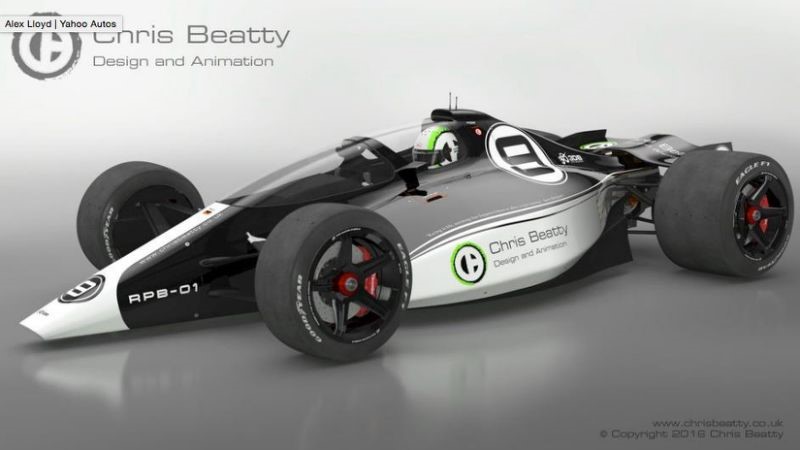IndyCar in futile effort to add bandaids to existing car
| "Why is IndyCar trying to put bandaids on the existing car instead of designing a new car for 2020 with a proper full canopy system? Trying to add a partial canopy forward of the driver is going to destroy the looks of the car and destroy the car's aerodynamics." AR1.com |
Nearly a year after IndyCar Series driver Justin Wilson was fatally struck by flying debris at Pocono (Pa.) Raceway, Indianapolis-based racing officials believe they have found the next way to protect drivers from injury writes Curt Cavin of the Indy Star.
Dr. Terry Trammell, who is leading IndyCar's effort to improve cockpit safety, prefers to call the design a deflector rather than a windshield, and he said it's certainly not an enclosed canopy, as Top Fuel dragsters use.
Assuming it's implemented, Trammell told IndyStar the curved protection will give Indy cars the look of a fighter jet since the single curved piece is modeled after an F-16's bubble.
What Trammell can't describe is the timeline for implementation. Maybe it's next year, maybe the year after. But it's likely coming, he said Wednesday.
"Trying to retro-fit it onto our (existing) tub is taking a little bit of ingenuity, and we're working on it," he said. "We're not making any pronouncements on when it's going to be done other than to say we're working on it daily."
Motor sports is littered with examples of exposed drivers being struck by debris, and in open-wheel racing the concern is for the top portion of the helmet. Wilson's was struck by a piece of a broken nose cone from Sage Karam's crashed car. Wilson died the next day. IndyCar reacted by adding tethers to several large car pieces, including the nose cones.
Trammell acknowledged the numerous variables that must be accounted for, led by the fact a driver shouldn't be subjected to one of these new deflectors breaking. There also are visibility and weight issues to consider, and the thickness of the ballistic material impacts each.
IndyCar President Jay Frye said there are secondary factors, too, like how a change in airflow over the car affects other things.
"It seems very elementary, but it's not," Frye said of the process. "But I'm certain we can figure it out. We're digging."
| "Either they should do a full canopy the right way, or do nothing at all." AR1.com |
Formula One has discussed a halo mounted by a pillar in front of the driver, but that would be problematic when a driver's sightline changes from a relatively flat street circuit to a banked oval track.
Trammell said IndyCar has enough crash data accumulated over the years to know how much force a deflector must withstand.
"We know what it takes to stop something at each energy level," he said. "But just like (driver) seats, sooner or later you have to draw a line and say, ‘OK, is this going to stop everything?'
"We know we're not going to get everything, and that has to do with weight and thickness of the material and the optics."
Trammell said a round of testing still to come centers on the actual deflection.
"If it works to deflect the piece in such a way that it's not harmful to (another car), they should have an equal shot at deflecting it again," he said. "If we can do that, it should solve most of the problems we've experienced in the past."
One type of incident Trammell isn't worried about is Josef Newgarden's second impact June 12 at Texas Motor Speedway. Trammell said it's likely most of those forces were the result of the car's roll hoop penetrating the SAFER barrier, which caused the car to pivot into the wall.
"It's hard to say, of course, but a (deflector) in that case probably wouldn't have interacted with the wall at all," Trammell said.
IndyCar's drivers have largely taken a wait-and-see approach, in part because they've been shown only some of the designs. Having something to test, which could come this fall, will be the point at which opinions are most formulated.
 |
| "The 2020 IndyCar should resemble this. They are wasting their time on a futile effort to apply bandaids to the existing car. Take off all those ugly appendages on the existing car and put driving back in the driver's hands" AR1.com |
 |
"Most of what we've seen is what Formula One has done, which even they seem to be slowing down on," owner/driver Ed Carpenter said. "I don't want to say I'm against (a shield), because I'm never against something that's better for us, but I haven't really seen enough to know what we're looking at, how it would work, what they've done to prove it's safer for everything."
Graham Rahal said he's seen enough of IndyCar's "conceptual ideas, which I like," but he wonders if such a piece can be properly fitted to the existing car.
"(Top Fuelers) have a tube frame and they could weld some extra fittings in and plop the canopy on there," he said. "For us it's a very different thing (because) we don't have tubes to weld something onto. The car almost has to be built around that."
Juan Pablo Montoya supports the effort so long as the potential downsides are accounted for.
"If you're pinned in there, how the hell are you going to get out?" he said. "It's a lot of factors, like tear-offs, too. If you have a big windshield, you're going to have to have tear-offs and when one of those comes off there's going to be (litter) on the track.
"There's always the ups and the downs."
Which is why Trammell can't predict the timeline for implementation.
"I wouldn't rule out anything or rule in anything," he said. "It's a developmental process and you never know where it's going to go and how fast it's going to get there." Curt Cavin/IndyStar
